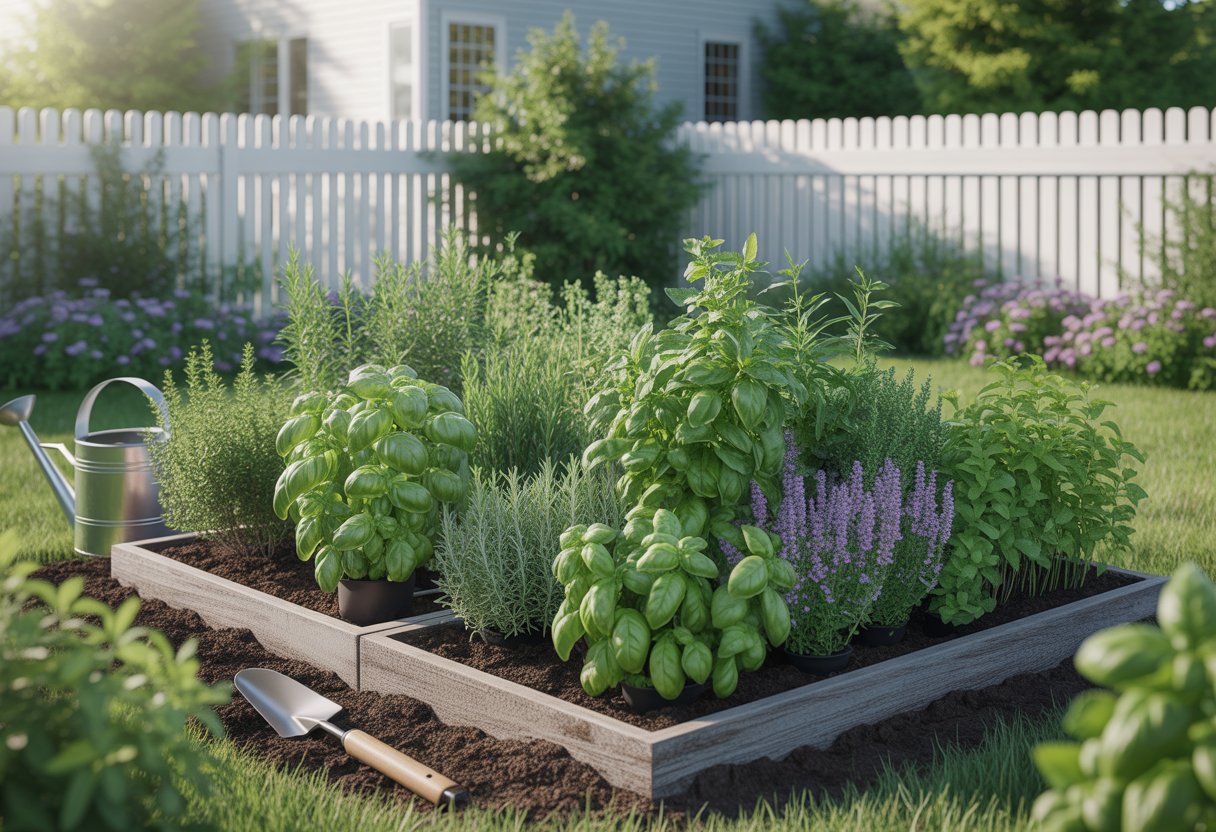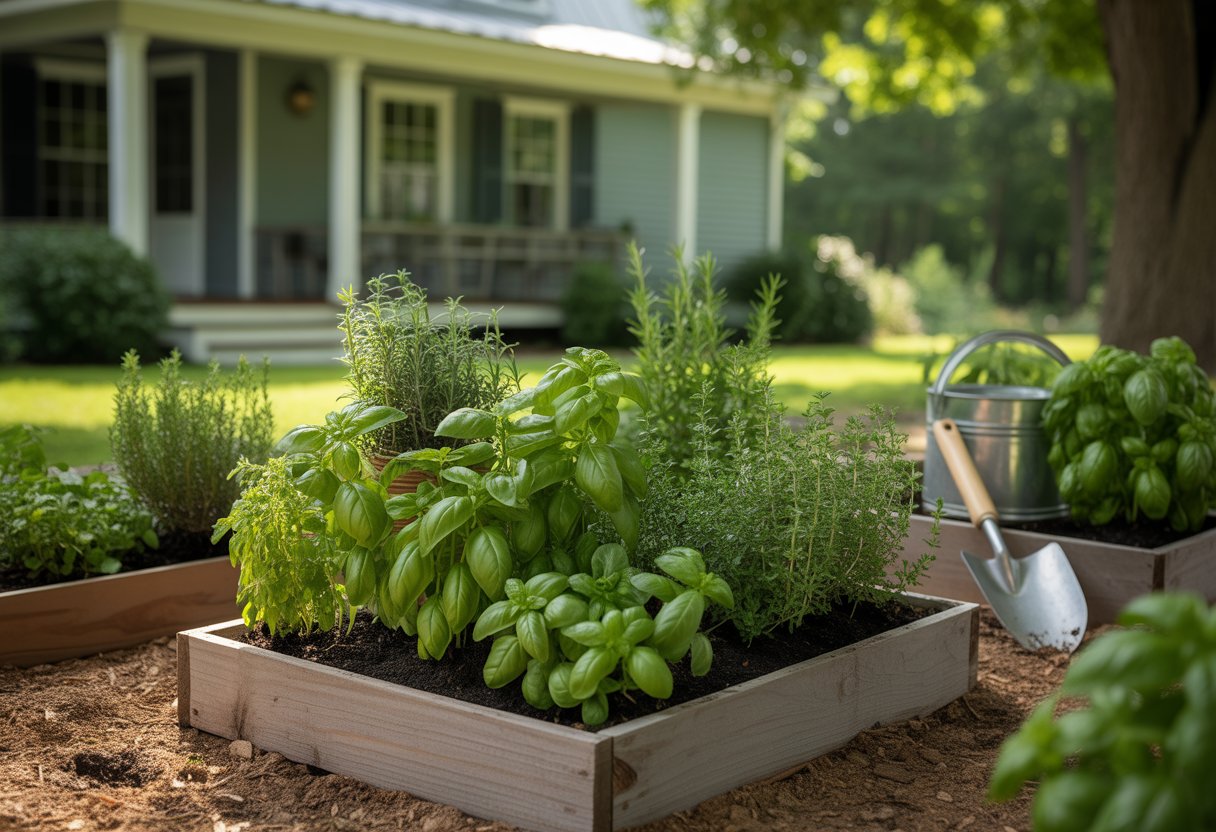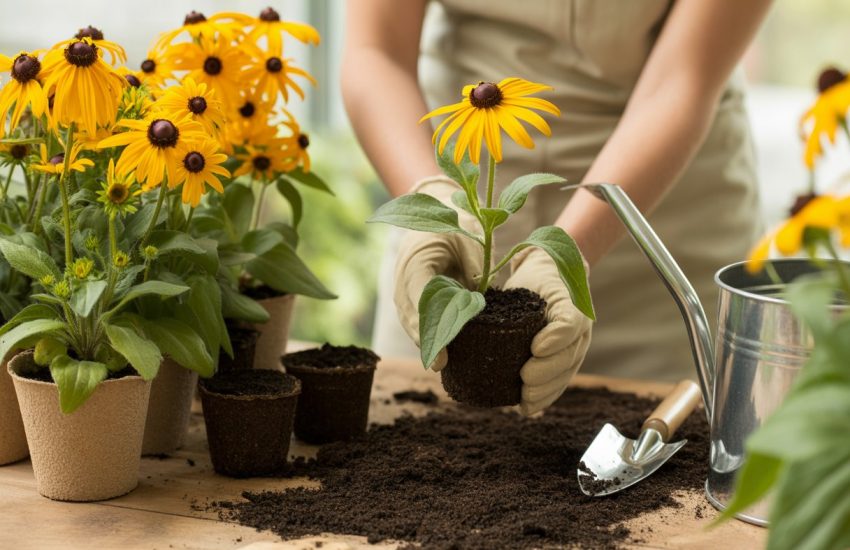Herb Gardening Tips for Alabama: Essential Advice for Thriving Herbs in Southern Climates
Growing herbs in Alabama isn’t just about sticking seeds in the dirt and hoping for the best. You’ve got to keep the state’s warm climate and unpredictable soil in mind.
The key to successful herb gardening in Alabama is picking heat-tolerant herbs and planting them in well-drained soil with lots of sunlight. That’s how you give your herbs the best shot, even with those brutal summers and surprise downpours.

Plenty of common herbs like basil, rosemary, and thyme do well here, but they’ll need extra water when things get dry. Timing matters too—plant too early and the heat can really hammer young herbs.
Understanding Alabama’s Herb Gardening Climate

Alabama’s climate shapes which herbs will actually make it and when you should plant them. Temperature swings, rainfall, and regional quirks all play a part in herb growth.
Plant Hardiness Zones in Alabama
Alabama covers USDA Plant Hardiness Zones 7a to 9a. Up north, it’s usually Zone 7a or 7b, with winter lows that can dip to 0°F.
Central Alabama mostly sits in Zone 8a or 8b, where winters rarely go below 10°F. Down south along the coast, it’s Zone 9a, and winters are pretty gentle—lows hover between 20 and 25°F.
If you know your zone, you can pick herbs that’ll actually survive. Hardy types like thyme and oregano handle the cold up north, while basil and rosemary like it warmer. It’s worth checking a zone map before you start, or you might end up replanting every spring.
Seasonal Considerations for Herb Growth
Alabama’s long, warm season usually runs from March to October. But those hot, sticky summers can stress out herbs like basil and cilantro.
Spring and fall are the sweet spots for planting, thanks to milder temps and more rain. When summer hits, a little afternoon shade and steady watering go a long way for delicate herbs.
Winter’s not too bad, unless you’re up north—then you might need to cover less hardy plants if frost sneaks in.
Best Practices for Starting an Alabama Herb Garden

Getting your Alabama herb garden off the ground means picking the right plants, prepping the soil, and laying things out so you’re not fighting nature every step of the way. The local climate and soil really do affect all of these choices.
Selecting Suitable Herb Plants
If you want herbs that’ll last through Alabama’s heat and humidity, you’ve got to choose wisely. Basil, oregano, rosemary, and thyme are usually solid bets.
Mint is a bit of a wild child—it’ll take over if you let it, so stick it in a pot unless you want a mint jungle. Native or well-adapted herbs usually dodge the worst pest and disease issues.
Plant cold-sensitive herbs after the last frost, which is usually mid-March. Annuals might need replanting, but perennials like chives can pop back up in spring.
Most herbs need 6-8 hours of sun, so don’t skimp on sunlight. If you’re growing fussier types, a little shade during peak summer can help them hang on.
Preparing Soil and Using Compost
Alabama soils can be pretty sandy or heavy with clay, so you’ll want to boost soil structure and fertility. Well-aged compost is your friend—it adds organic matter, holds moisture, and helps with drainage.
A soil test can tell you if you need to tweak the pH. Most herbs like it a bit acidic to neutral (pH 6.0–7.0). Lime bumps up pH if it’s too low, while sulfur drops it if it’s too high.
Work 2 to 3 inches of compost into the top 6–8 inches of soil. Don’t go overboard with nutrients, though—herbs with too much fertilizer get big and leafy but lose their punch. That’s not what you want if you’re after flavor.
Establishing Raised Beds and Mulching
Raised beds make life easier if you’re dealing with clay or compacted soil. They help with drainage and let you amend the soil without digging up your whole yard.
Build beds 6-12 inches high, and keep them 3-4 feet wide so you can reach everything. Untreated wood or other safe materials are best—no one wants chemicals near their food.
A layer of organic mulch (2-3 inches) like shredded bark or straw helps keep moisture in and temperatures steadier. It’ll also cut down on weeds and some diseases, which is a relief in Alabama’s humidity.
Check the mulch from time to time, and add more if it gets thin. Too much, though, and you could smother your plants’ roots.
Essential Care and Maintenance Tips
Caring for herbs in Alabama means sticking to a few basic routines. Watering, managing volunteers, and encouraging strong growth all matter if you want fresh herbs on your table.
Regular Watering and Moisture Management
Herbs in Alabama need consistent watering, especially during those roasting hot stretches. Most need about 1 inch of water a week, but it can vary.
Water early in the morning so less evaporates and you’re less likely to get fungal issues. Good drainage is crucial—soggy roots are pretty much a death sentence for herbs.
Mulch helps keep moisture steady, but don’t drown your plants. A soaker hose or drip system waters deeply without soaking the leaves, which keeps diseases in check.
Managing Volunteers and Weed Control
Volunteer herbs—those surprise seedlings—sometimes pop up where you didn’t plant them. Some are handy, but others crowd out your planned herbs. Pull unwanted volunteers as soon as you spot them.
Weeds are relentless, so regular pulling is a must. Mulch helps with weed control and keeps the soil moist at the same time.
If your herb garden sits near other plants, you’ll probably have to check for weeds more often. Sometimes it feels never-ending, but it’s worth it.
Ensuring Healthy Growth of Fresh Herbs
Pruning makes herbs bushier and healthier. Pinch off flower buds on basil and oregano to keep the leaves coming.
Deadheading works for flowering herbs like thyme, encouraging new shoots. Don’t go nuts with fertilizer—just a light touch with a balanced, slow-release type during the season.
Compost or organic matter is usually enough to keep things growing. Rotate your herbs each year to dodge disease and keep the soil from getting tired.
Six hours of sun (at least!) is non-negotiable for happy herbs in Alabama. Anything less, and they’ll just limp along.
Recommended Herbs for Alabama Gardens

Alabama’s warmth lets you grow a bunch of herbs, as long as you pay attention to their quirks. Picking the right ones and knowing what they like can make all the difference.
Growing Basil, Chives, and Parsley
Basil loves full sun and soil that drains well but holds a bit of moisture. Don’t let it dry out, but don’t drown it either.
If you keep pinching off the flowers, you’ll get more leaves. Chives do fine in sun or part shade and handle the heat if you water them regularly.
They like soil that’s a touch acidic to neutral. Harvest often, and they’ll keep coming back.
Parsley is a bit slow to get going, but it’s steady once it’s established. It grows in sun or light shade and likes moist (not soggy) soil.
Mulch helps keep the roots cool and the soil damp during those steamy months.
Cultivating Mint, Spearmint, and Thyme
Mint and spearmint will take over if you’re not careful, so pots or barriers are a good idea. They handle Alabama’s heat but do better with some afternoon shade.
Thyme wants full sun and sandy, well-drained soil. Once it’s settled in, it can handle a bit of drought.
Prune thyme regularly to keep it bushy and to stop it from getting woody. It’s pretty tough, but a little attention goes a long way.
Tips for Cilantro, Dill, Sage, and Rosemary
Cilantro does best in Alabama’s cooler seasons—think spring or fall. When the heat cranks up, cilantro just bolts and fizzles out.
Give it well-drained soil. If things dry up, water it now and then, but don’t overdo it.
Dill likes full sun, plus light, fertile soil with decent drainage. I find it appreciates frequent, shallow watering.
Don’t crowd your dill plants—they need space to breathe.
Sage? Put it in full sun and dry, well-draining soil. Honestly, too much water or soggy roots will ruin it.
Prune sage every so often to keep it looking tidy.
Rosemary loves hot, dry weather and plenty of sun. Let the soil drain well and don’t water too often.
A little mulch can help keep moisture in, but avoid turning the soil into a swamp.


